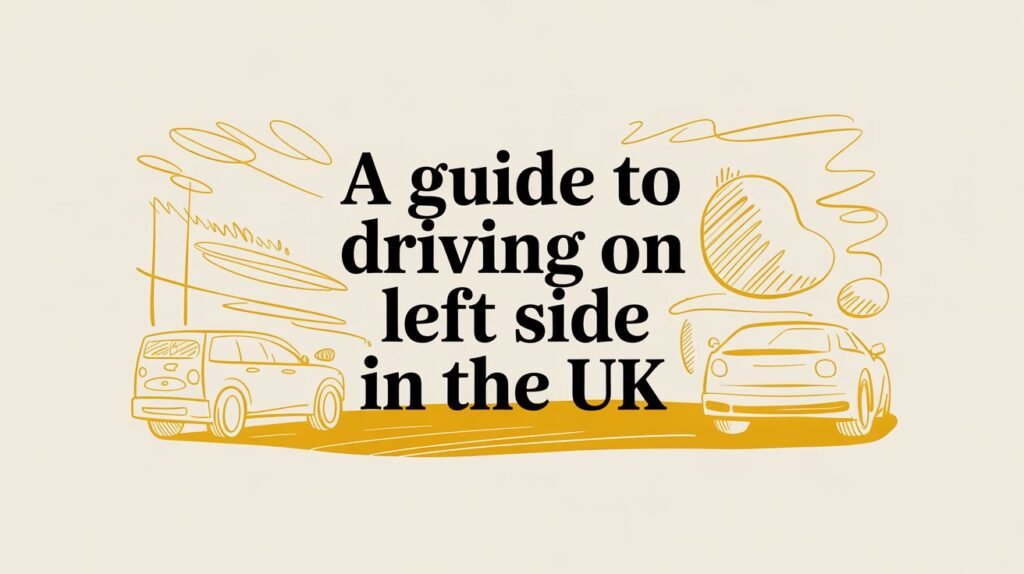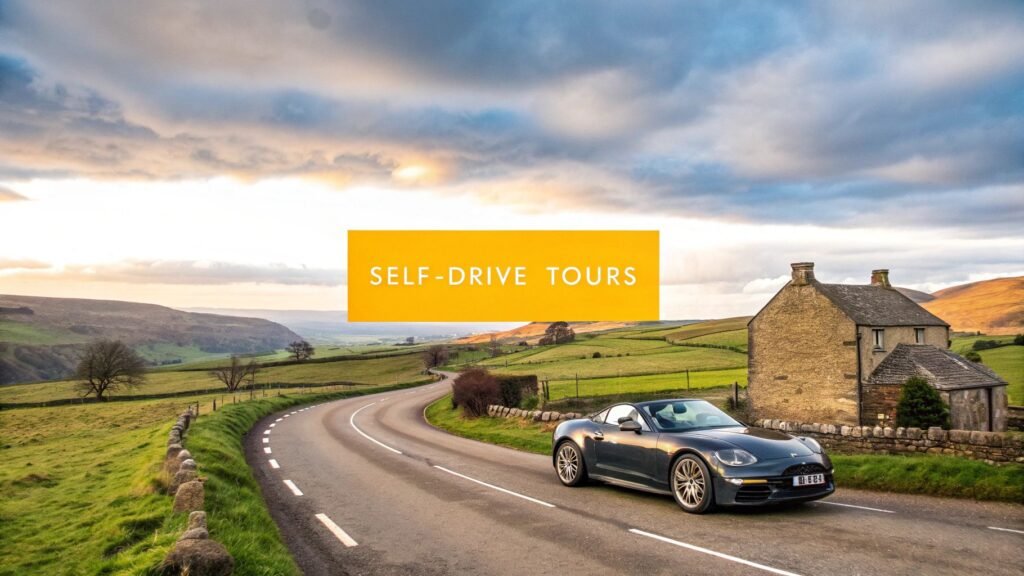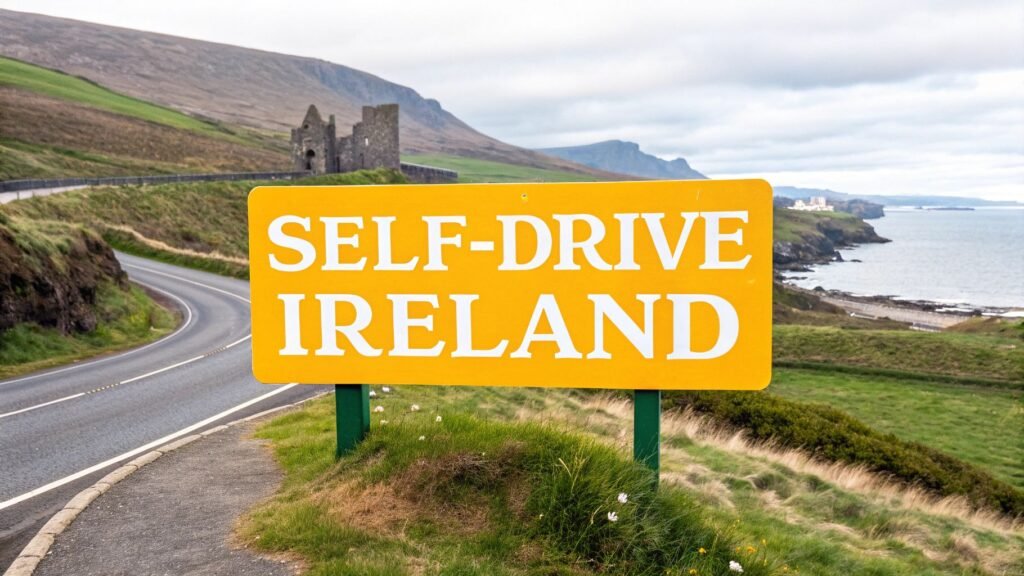The idea of driving on the left for the first time can feel a bit intimidating, but it’s a hurdle that millions of visitors to places like the UK, Australia, and Japan clear every year. The trick is to reframe it in your mind. Don't think of it as driving on the "wrong" side; think of it as adjusting to a different driving position on the road.
Your First Drive on the Left Side of the Road
Those first few moments in the driver’s seat are where your confidence will start to build. For many, that first real test is navigating out of the airport rental car park.
Before you even start the engine, just sit for a moment. Get a feel for the car. You're now in the right-hand seat, but the good news is the pedals are exactly where you expect them: accelerator on the right, brake in the middle, clutch on the left. The gearstick, however, is now on your left, which will feel odd if you're in a manual. You'll be shifting with your non-dominant hand.
Your biggest mental adjustment will be lane positioning. From the right side of the car, your entire view of the road is skewed from what you're used to. It's incredibly common for first-timers to hug the left-hand kerb, simply because your brain is trying to put the bulk of the car where it feels it should be.
A Pro Tip for Staying Centred: Consciously keep your body (the driver's side) closer to the centre line of the road. This one simple thought helps you fight the instinct to drift left and keeps you perfectly positioned in your lane.
This map gives you a great visual of just how many countries drive on the left.
So, while it feels foreign at first, you're actually in good company with a huge chunk of the world's drivers.
Building New Habits Quickly
The key to a stress-free experience is to form the right habits from the get-go. If you have a passenger, make them your "kerb-side spotter" to help you gauge the distance on your left. It really helps.
Here are the crucial new rules to drum into your head immediately:
- Roundabouts: These are everywhere in the UK. The golden rule is simple: traffic flows clockwise, and you always give way to cars already on the roundabout, coming from your right.
- Turning: Left turns are simple and "tight"—you just peel off into the nearest lane. Right turns are "wide" and require more care, as you'll have to cross a lane of oncoming traffic.
- Motorways: Think of it as a mirror image. The far-left lane is your main driving lane (the "slow lane"). The lanes to your right, especially the far-right lane, are strictly for overtaking.
It’s a fascinating bit of history that around 35% of the world's population drives on the left. This isn't some new-fangled idea; in the UK, it was officially mandated by the Highway Act of 1835. Car manufacturers naturally followed, putting the steering wheel on the right to give drivers the best possible view of oncoming traffic. You can read more about the quirky history of UK driving on historyextra.com.
Once you’ve got the hang of it, exploring the country by car is an absolutely brilliant way to travel. Our range of self-drive tours can give you some fantastic ideas for your next road trip adventure.
How to Navigate UK Roundabouts and Junctions
For many visitors, the mere thought of a UK roundabout is enough to cause a spike in anxiety. They can look chaotic, but they’re actually designed to keep traffic flowing smoothly. Once you get the hang of them, they become second nature. Mastering roundabouts is probably the biggest step you'll take towards feeling confident on UK roads.
The golden rule is incredibly simple: always give way to traffic already on the roundabout, which will be coming from your right. As you get close, slow right down and look to your right. If you see a safe gap, you can merge. If not, you wait. It's as simple as that.
This infographic breaks down some of the core mental shifts you'll need to make.
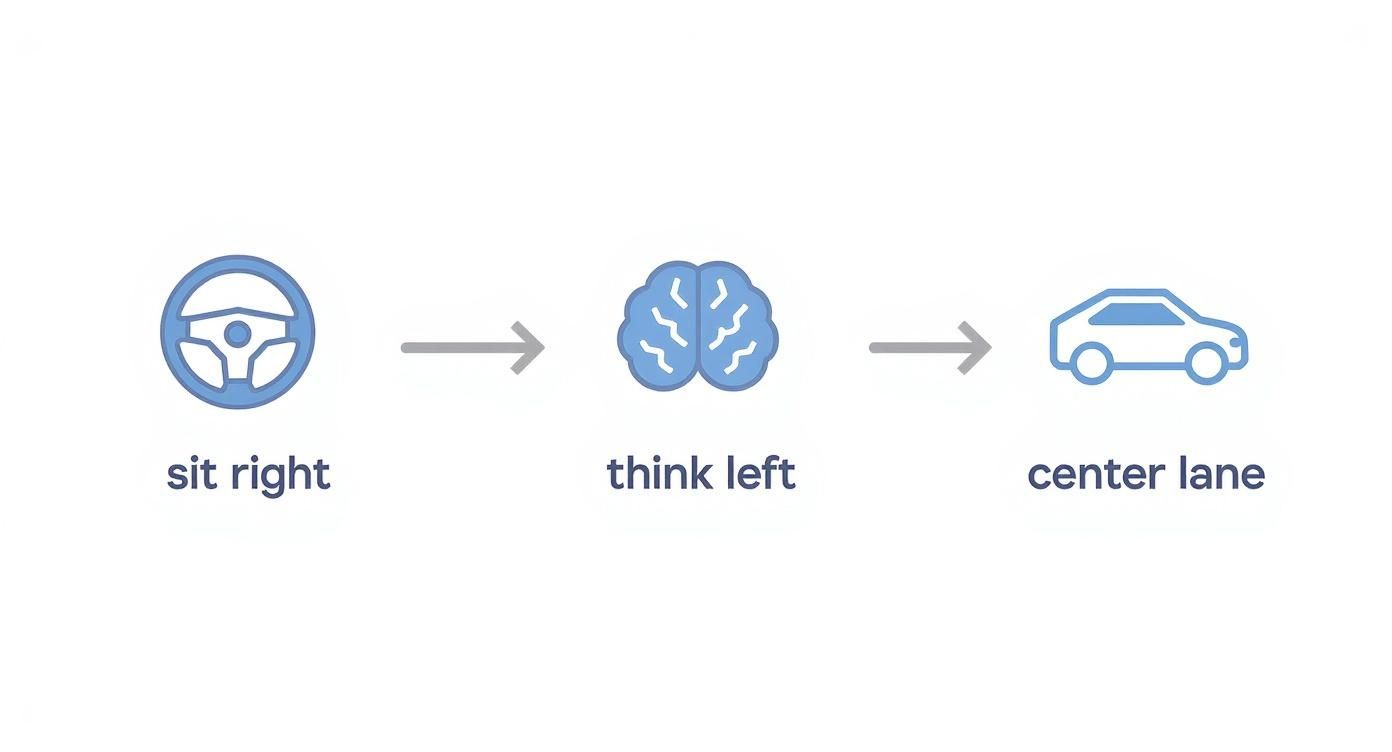
It’s all about getting your brain to automatically think "left," from where you sit in the car to which lane you stick to.
Choosing Your Lane and Signalling
How you approach the roundabout sets you up for success. Pay close attention to the road markings and signs on the way in; they will almost always tell you which lane you need for your exit.
- Turning Left (First Exit): Stick to the left-hand lane on your approach and signal left. Keep that signal on until you've left the roundabout.
- Going Straight On: Usually, you'll use the left-hand lane unless a sign points you elsewhere. Don't indicate as you approach. Only signal left just after you pass the exit before the one you want to take.
- Turning Right (Last Exit or Full Circle): Approach in the right-hand lane and signal right. You'll keep this right signal on until you’ve passed the exit just before yours. Then, you switch to your left signal to show everyone you're about to exit.
One of the most common mistakes visitors make is signalling at the wrong time, which really confuses local drivers. Think of it like a story: your lane choice sets the scene, your signal on the roundabout develops the plot, and your final exit signal is the clear conclusion.
The best way to get comfortable is by doing. A self-drive holiday is the perfect practice ground. Planning something like an 8-day self-drive tour of England means you'll encounter all sorts of roundabouts, from tiny ones in quiet villages to huge multi-laners in cities, letting you build your skills at your own pace.
Tackling T-Junctions and Crossroads
It’s not just roundabouts that require that "think left" mindset. At a standard T-junction, where your road meets a main road, you must give way to all traffic already on that main road before you even think about pulling out.
Crossroads are often controlled by traffic lights, 'Stop' signs, or 'Give Way' markings. A 'Stop' sign is absolute—you must come to a full stop behind the line, look carefully, and only proceed when it is completely safe. A 'Give Way' marking means you have to yield to traffic on the main road, but you don't have to stop if the way is clear.
A simple little mantra can be a lifesaver for turns: "Tight left, wide right."
- A left turn is easy. You’re just staying on your side of the road and hugging the kerb as you turn into the nearest lane.
- A right turn is trickier because you have to cross the path of oncoming traffic. You need to position yourself towards the centre of the road, wait for a safe gap, and then make a "wide" turn into the correct lane on the road you're joining. It feels strange at first, but it's essential for staying out of trouble.
Getting to Grips with UK Road Rules and Your Car
Getting comfortable driving on the left is only half the battle. The other half is feeling at home in a car where everything seems to be on the "wrong" side. The moment you slide into the right-hand driver's seat of your rental, you'll realise things are a little different.
First things first, the pedals are where you expect them to be: accelerator on the right, brake in the middle, and clutch on the left. Phew. But the gearstick is now on your left side. If you've hired a manual car, this is probably the biggest mental hurdle. Before you even think about leaving the car park, spend a good few minutes just sitting there, running through the gears with your left hand. It feels odd at first, but it's surprising how quickly your muscle memory starts to adapt.
Your New View from the Cockpit
Sitting on the right completely changes your perspective. Your whole sense of where the car is on the road shifts. Don't be surprised if the indicator and windscreen wiper stalks are swapped, either. It’s a classic tourist mistake to flick on the wipers when signalling for a turn – we’ve all been there!
Your mirrors become your new best friends. The rearview mirror is now a glance to your left, not your right. The left-side wing mirror is suddenly crucial for judging your distance from the kerb, especially on those charming but incredibly narrow country lanes. You'll be checking it constantly to avoid scuffing your wheels.
The best advice I can give? Take your time. Before pulling out of the rental car park, adjust every mirror, find the lights, locate the wipers, and just breathe. A calm, unhurried start to your journey will make all the difference.
UK Speed Limits and Road Signs
Understanding speed limits in the UK is pretty simple because they're all posted in miles per hour (mph). The tricky part is knowing the national speed limits, which apply whenever you don't see a specific speed limit sign. Getting this wrong can lead to some expensive holiday photos from a speed camera, so it's well worth memorising them.
Here's a quick rundown of the national speed limits for cars, which you should follow unless a sign tells you otherwise.
Quick Reference for UK National Speed Limits
| Road Type | Speed Limit (mph) |
|---|---|
| Motorways (e.g., M1, M25) | 70 mph |
| Dual Carriageways | 70 mph |
| Single Carriageway Roads | 60 mph |
| Built-Up Areas (with streetlights) | 30 mph |
Most UK road signs are quite intuitive, especially if you've driven elsewhere in Europe. Pay special attention to signs for roundabouts, as they give you a diagram of the exits. A key sign to know is the red circle with a white horizontal bar, which means 'No Entry'. A solid blue circle, on the other hand, gives you a mandatory instruction, like 'Turn Left Only'.
How to Handle Pedestrian Crossings
The UK has a few different types of pedestrian crossings, and knowing how to approach each one is vital for everyone's safety.
- Zebra Crossings: These are marked by the iconic black and white stripes on the road. You must stop and give way to anyone who has stepped onto the crossing. It's not optional.
- Pelican Crossings: These have traffic lights. The confusing part can be the flashing amber light, which means you must give way to pedestrians still crossing but can proceed if the way is clear.
- Puffin Crossings: These are a bit smarter, using sensors to detect when the crossing is clear. You won't see a flashing amber phase here; you just wait for the green light.
Learning these rules is especially important if you're planning a proper road trip, like an 8-day self-drive tour of Scotland. On a journey like that, you'll go from bustling city streets to remote country roads in a single day, encountering all of these situations. A little preparation goes a long way in making sure your adventure is memorable for all the right reasons.
Mastering Motorways and Overtaking Safely
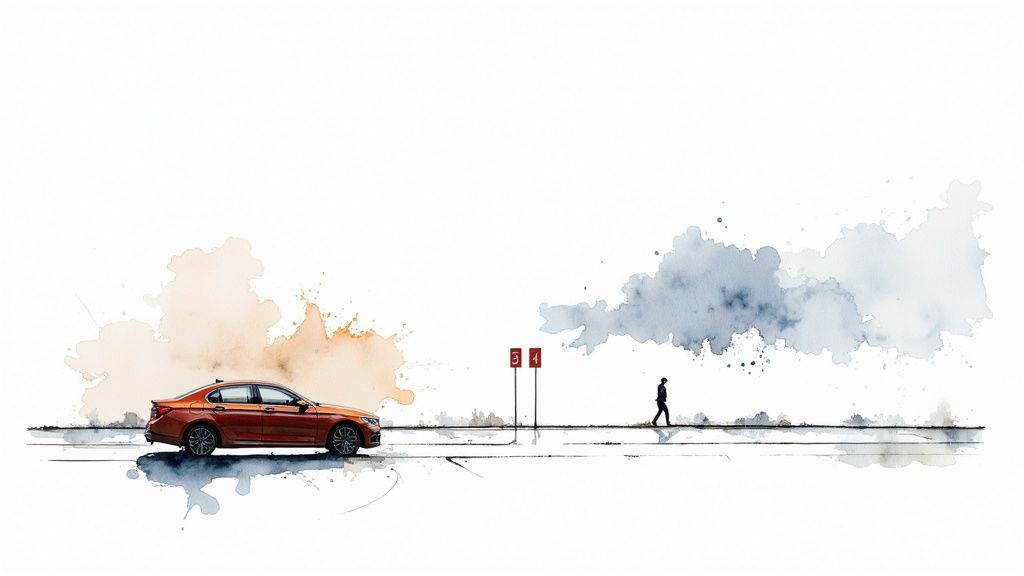
Getting onto a UK motorway for the first time can feel a bit intense. The pace is faster and the rules are more rigid, but they are hands-down the best way to cover serious ground. The key to it all? Lane discipline.
It’s a concept that trips up a lot of visitors. On a British motorway, the left-hand lane is your home. It’s not the "slow lane" – it's the main driving lane. You should be in it at all times unless you are actively overtaking another vehicle.
When you do need to pass someone, you always do it on the right. As soon as you're safely past, your job is to move back into a clear lane on your left. Hanging out in the middle or right-hand lanes when the left is empty isn't just bad form that annoys local drivers; it can actually land you a fine.
My best piece of advice is to make this your mantra: "Stay left unless overtaking." If you can drill that into your head, you've mastered the most important part of UK motorway driving and you'll keep the traffic flowing smoothly for everyone.
Getting On and Off the Motorway
Joining the motorway feels more dramatic than it is. As you come down the slip road, your main goal is to match the speed of the traffic in the left-hand lane. Check your mirrors, signal your intention, find a safe gap, and merge. Whatever you do, try not to stop at the end of the slip road unless it’s an absolute emergency.
Getting off is much simpler, thanks to countdown markers. Look for the blue signs with one, two, or three white diagonal bars – they mark 300, 200, and 100 yards to your exit. These are your signal to get into the left lane and indicate that you're leaving.
Blind Spots and Keeping Your Distance
If you’ve brought your own left-hand drive car over, you have to be extra careful. Your blind spots will be in different places, particularly over your right shoulder when you're looking to merge or overtake. It demands another level of awareness. Consider that in 2020, around 5% of the 3,175 accidents involving lorries were with less common left-hand drive models. It's a stark reminder that being in a vehicle not built for UK roads requires you to be doubly vigilant.
One of the most valuable habits you can build is sticking to the "two-second rule."
- Watch the car ahead and pick a fixed point, like a lamp post or a bridge.
- When their rear bumper passes that point, start counting, "One-thousand-one, one-thousand-two."
- If your front bumper passes the same point before you finish the count, you're following too closely.
This simple trick gives you the buffer you need to react and brake safely if something unexpected happens up ahead. Nailing these motorway skills won't just keep you safe; it will make your journey far less stressful, freeing you up to enjoy the incredible sights on a proper tour of England's historic roads.
Common Driving Mistakes and How to Avoid Them
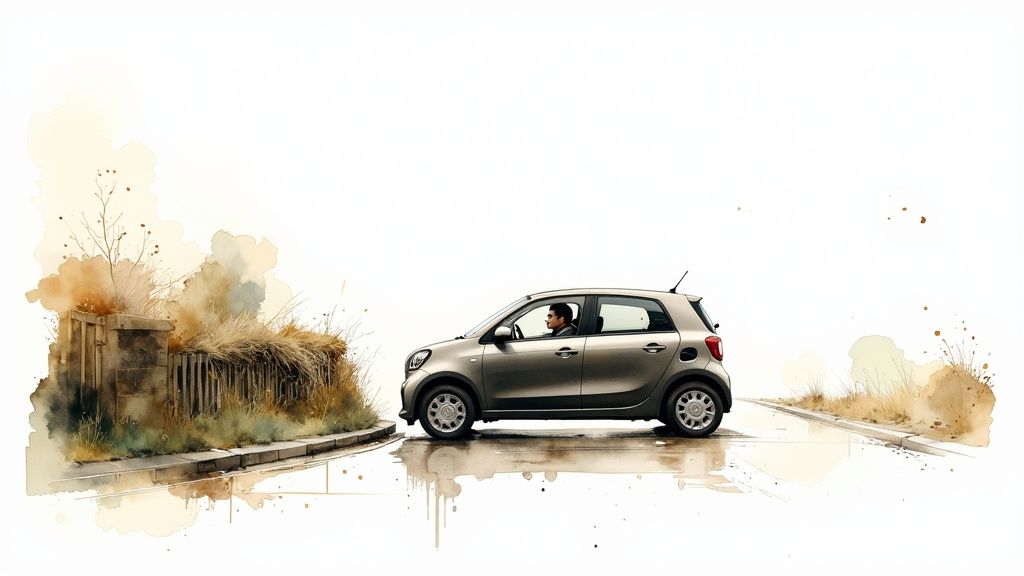
Even with all the preparation in the world, a few common slip-ups can catch you out when you’re new to driving on the left. Knowing what they are beforehand is the best defence. After all, forewarned is forearmed, right?
One of the most dangerous moments isn't on a packed motorway, but in a quiet, empty car park. When you're pulling out of a petrol station or a deserted lot, there are no other cars to give you a visual cue. This is when muscle memory kicks in, and your brain can instinctively steer you onto the right-hand side of the road.
This is a critical moment. Before pulling away, take a deliberate breath and tell yourself, "Stay left, stay left." It sounds almost silly, but that little mental prompt can be a genuine lifesaver. It reinforces the new rule right when your old habits are most likely to take over.
Misjudging Your Car's Position
Another classic rookie mistake is getting your car's position wrong. From the right-hand driver's seat, your entire sense of spatial awareness is flipped. This makes it ridiculously easy to scrape your left-side wheels along the kerb, especially on tight left turns or down narrow village lanes.
To get a better feel for it, start using your left wing mirror far more than you normally would. It’s your best friend for judging the gap between your car and the kerb. You can also try a little visualisation trick:
- Imagine a line shooting straight ahead from your right hip. This imaginary line should track roughly along the centre of your driving lane.
- Keep glancing at that left mirror to check the kerb's position in relation to your car.
Doing both—looking ahead and checking your side—helps recalibrate your brain's map of the car, preventing those tell-tale scuffs on the rental’s alloy wheels.
Roundabout Gaffes and Other Lapses
Roundabouts are a big one, but a frequent slip-up is entering in the wrong lane out of habit. If you need to turn right (say, the third exit), you absolutely must approach in the right-hand lane. Getting this wrong can cause chaos and might force you into a risky last-minute lane change on the roundabout itself. Always, always check the road signs and markings on approach.
A crucial heads-up for anyone driving their own car over from mainland Europe: you have to sort out your headlights. Headlights on left-hand drive cars are angled to avoid blinding oncoming traffic on the right. In the UK, that means they'll shine directly into the eyes of other drivers. You must either apply headlight deflector stickers or adjust the beam pattern to drive legally and safely after dark.
Finally, a simple mantra for every junction: "Tight left, wide right." A tight left turn keeps you neatly in your lane. A wide right turn is what you need to safely cross the oncoming lane and enter the correct side of the new road. Repeating this to yourself can make a huge difference, making your entire experience of driving on the left much safer and, frankly, a lot less stressful.
Your UK Driving Questions, Answered
It's completely normal to have a few nagging questions before you get behind the wheel in a new country. Let's run through some of the most common queries I hear from drivers, so you can feel confident before you even turn the key.
What's the Hardest Part About Driving on the Left?
You might think it would be navigating a busy motorway, but for most people, the real challenge comes when you slow down. It’s those quiet, almost automatic moments – like pulling out of a supermarket car park or turning onto an empty country lane – where your muscle memory from driving on the right can suddenly take over. This is when you have to be most mindful.
Another big one is whether to hire an automatic or a manual car. My advice? Unless you are incredibly comfortable driving a manual at home and fancy a real challenge, always choose an automatic. The small extra cost is well worth it. It frees up so much mental space, letting you focus on your road positioning and the traffic around you, rather than trying to shift gears with your left hand.
How Do I Handle Tricky Road Scenarios?
Ah, the infamous narrow country lanes. They look daunting, but the trick is simply to take your time and be ready to stop. You'll notice little cut-outs or wider areas along these roads – these are designated passing places. Keep your eyes peeled for them as you drive.
On single-track roads, there’s an unwritten code of courtesy. Whoever has the easiest access to a passing place is generally the one who pulls in to let the other car through. A little wave to say thanks is standard practice and always goes down well.
This simple bit of cooperation is what makes driving these beautiful, historic lanes a pleasure rather than a panic.
But what if you make a mistake and find yourself on the wrong side of the road? First off, don't beat yourself up – it happens, especially on quiet roads with no other cars to follow.
- The moment you realise, find a safe spot to pull over to the left.
- Stop the car completely. Take a second to breathe and get your bearings.
- Don't rush back into traffic. Wait until you're ready, then consciously and deliberately pull out, reminding yourself to "stay left."
A calm and quick correction is all it takes. Getting these worries sorted out now means you can spend less time stressing and more time enjoying the drive.
Ready to take on the UK's incredible roads? At BTOURS, we craft bespoke self-drive holidays that take all the guesswork out of your trip. Find your perfect itinerary and start planning your adventure at https://www.btours.com.

